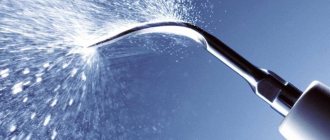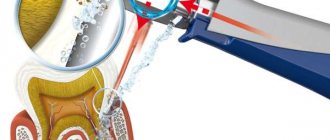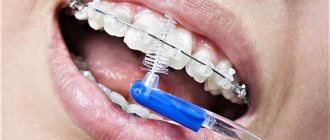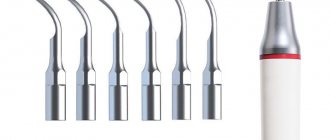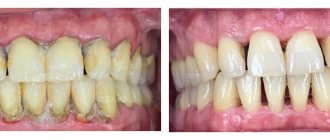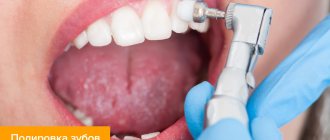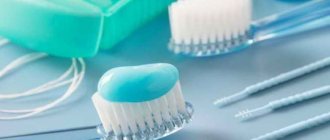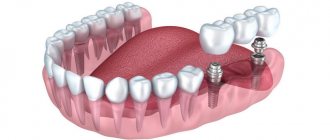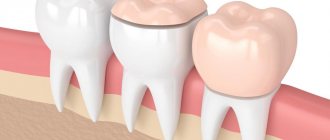Regular and high-quality brushing of teeth from plaque and deposits is the best measure to prevent the development of all kinds of dental diseases. Previously, it was carried out exclusively by mechanical methods, but today modern dentistry offers patients a more effective method - ultrasonic teeth cleaning, which allows you to get an excellent positive result of cleaning dental surfaces with a minimum of negative consequences for the healthy state of the natural enamel coating.
In the article we will talk in detail about the procedure: we will find out its features, advantages, and prices for ultrasonic teeth cleaning in Moscow.
What is it: ultrasonic teeth cleaning?
To perfectly clean your teeth from plaque and tartar, regular brushing and toothpaste will not be enough. It is necessary to regularly visit the dentist's office, where the sanitation of the oral cavity is carried out using professional methods, one of which is ultrasonic teeth cleaning. What kind of procedure is this?
Cleaning dental surfaces with ultrasound is an innovative method of sanitation of dental surfaces, which uses a specialized scaler apparatus. Its use in the procedure allows you to efficiently clean the enamel coating from all types of deposits - both hard and soft. Thanks to such thorough cleaning, it is possible not only to ensure ideal whiteness of teeth, but also to successfully prevent caries and other dental diseases.
Removal with hand tools and chemical detergents
Using tools to remove deposits “manually” can be quite effective, with virtually no risk of tissue damage. But this method has many disadvantages: high labor-intensive and time-consuming manipulations, tools need to be sharpened, and after removing deposits, additional polishing is necessary, since the surface becomes uneven.
The use of the manual method in patients with orthopedic structures has its own characteristics. It is not recommended to use the traditional vertical technique for removing deposits, as it can accidentally damage the edges of the structure and disrupt the edge seal. This can lead to decementation of the structure, the occurrence of caries and inflammation in the marginal periodontium.
In patients with dentures, it is recommended to use a horizontal scaling technique, where the instrument moves parallel to the edge of the structure. It is better to use special curettes (for example, Gracie curettes).
The chemical method is rarely used to remove dense deposits from moving teeth. The gel is applied with a swab for preliminary softening, then washed off with water. Next, the softened deposits are carefully scraped off with hand tools.
The principle of useful action of the scaler
As we mentioned above, ultrasonic teeth cleaning uses a special type of device – a scaler. The device works as follows:
1. It conducts ultrasonic vibration on tooth surfaces.
2. Ultrasound waves have a destructive effect on all types of dental plaque - hard and soft deposits.
Ultrasonic teeth cleaning
from 2000 rub. More about prices
We have been working since 1994
we are one of the first to open private dentistry in Moscow
Best materials
only new and modern equipment for dental treatment
Free
consultation with a dentist
Payment options
- cash
- plastic cards
- cashless payments
Doctors' experience
- with great experience
- graduated
- conference participants
Ultrasonic baths
The device cleans the prosthesis efficiently: after treating the product in the bath, there will be no plaque or stone left on it.
Outwardly, it looks like a container made of stainless steel (other metals that are not susceptible to rust can also be used), on the bottom or walls of which ultrasound emitters are placed.
The principle of operation of the device is as follows: sound waves pass through plain water or other cleaning liquid, during which contamination is completely removed from the products placed in the bath.
The advantages of cleaning in an ultrasonic bath are undeniable:
- allows you to clean hard-to-reach places;
- extends the service life of the prosthesis;
- the quality of cleaning is higher than with the manual cleaning method;
- the likelihood of damage during the procedure is minimal.
The cost of such an ultrasonic bath depends on many characteristics: volume and dimensions (for the same volume, the dimensions of the device may vary); frequency and maximum power (the higher these indicators, the more effective the cleaning will be); the presence of a heating system (the function allows you to improve the quality of cleaning); the presence of a timer and a system that controls the temperature of the environment.
Ultrasonic teeth cleaning before and after photos of our patients
Photo before
Photo after
Photo before
Photo after
Photo before
Photo after
In terms of its action, a dental scaler is a universal tool, since its use allows you to remove tartar from the enamel, as well as efficiently clean the space under the gums and between the teeth from pathogenic microorganisms.
Ultrasonic teeth cleaning is carried out without anesthesia, since all manipulations performed by the doctor are absolutely painless for the patient and do not cause any discomfort.
Ultrasound cleaning does not entail negative side effects, but quite the opposite - it helps prevent diseases of the teeth and gums and improve their health. Reviews of ultrasonic teeth cleaning from patients confirm that this method is not only painless and safe, it is most effective!
Daily hygiene procedures
You need to clean your dentures after every meal. The exception is structures that are fixed using an adhesive cream. In this case, you can do extraoral brushing once a day.
Rules for performing daily hygiene procedures:
- You need to clean your denture under running water, being careful not to drop it in the sink or on the floor.
- Only soft brushes and special products or non-abrasive toothpastes are suitable for processing.
- It is important to ensure that the plastic parts of the structure and metal hooks do not bend during cleaning.
Benefits of ultrasonic cleaning of dental surfaces
Ultrasonic teeth cleaning is valued by professionals for a number of the following advantages:
- The use of innovative equipment allows for high-quality treatment of the root canals of all teeth in the jaw, regardless of their position in the row.
- Dental surfaces are ideally cleaned of all types of deposits, including plaque from smoking and eating coloring foods.
- The natural enamel coating of the teeth is polished.
- Tooth enamel becomes several shades lighter. If you want to achieve the maximum effect of white teeth, use a teeth whitening service.
The price of ultrasonic teeth cleaning is slightly higher than for other professional hygiene measures, but the procedure allows you to obtain an ideal result of sanitation of the oral cavity without harm to the health of the patient’s teeth and the condition of natural tooth enamel.
Whitening dentures
If you do not care for the product correctly or do not care for it at all, it may darken over time. To return the original appearance, you will have to try.
Cleansing with whitening toothpaste is highly discouraged: as a rule, such toothpastes are highly abrasive, which allows them to fight plaque on teeth. However, the surface of the denture is not as hard as tooth enamel, so using such a paste will only cause harm.
If there is a need to whiten the denture, the best option would be to take it to the clinic, or resort to the help of special cleansing tablets. There is another option, but it is much more expensive - purchasing an ultrasonic brush, which makes it possible to carry out high-quality cleaning right at home.
Contraindications for ultrasonic cleaning
Before performing any medical procedure, it is important to consider not only the indications for it, but also possible limitations. Only in this case will the event be truly useful and safe for the patient.
There are few contraindications to ultrasonic teeth cleaning and the main ones are:
- Implants installed in the oral cavity;
- Some diseases of the heart muscle;
- Pathologies of the respiratory system and respiratory tract;
- A number of diseases of the gastrointestinal tract;
- Increased sensitivity of dentin.
Temporary restrictions on ultrasonic cleaning of dental surfaces are periods of pregnancy and lactation, the patient’s age under 18 years, the presence of infectious diseases and diseases of viral etiology.
To exclude possible contraindications to the procedure, before ultrasonic teeth cleaning, it is worth visiting a dentist for an initial examination and detailed consultation.
Effective cleaning products
To clean the denture, you will need a soft brush and low-abrasive toothpaste, which can be replaced with liquid soap.
In addition, there are tablets produced by a variety of manufacturers that are specifically designed for cleaning dentures. The most proven products are LACALUT and Corega. With their help, you can clean the prosthesis at home without using an ultrasonic bath. Of course, the quality will be a little worse, but it will be quite enough to maintain the prosthesis in good condition.
These tablets, due to the presence of special components in their composition, not only dissolve plaque, but also disinfect the product.
Each manufacturer includes instructions for use in the box with the drug, but the general rules are the same:
- dissolve the tablet in a glass of slightly warmed water;
- Immerse the denture in the liquid for 10 minutes.
Stages of the ultrasound teeth cleaning procedure
The process of ultrasonic teeth cleaning is divided into several main stages, including:
1. Preliminary inspection. The dentist examines the patient and assesses the condition of his teeth and enamel. If during the examination no contraindications to further manipulations are identified, the specialist begins preparation directly for the cleaning process.
2. Cleaning dental surfaces from deposits. At this stage, the specialist uses a scaler built into a special installation. The attachment of the innovative instrument generates ultrasonic vibrations and, simultaneously with ultrasound waves, a solution of water and medications is supplied to the surface of the teeth. In order for ultrasonic teeth cleaning to take place as efficiently as possible, it is extremely important that the specialist makes all movements of the nozzle in the right direction.
3. Polishing the enamel coating. To perform polishing manipulations, special brushes and professional pastes are used; in hard-to-reach areas, the dentist uses strips - ultra-thin strips on the surface of which an abrasive substance is applied. The strips are glued to areas that cannot be cleaned with a regular brush and are removed after a while.
The final stage of ultrasonic teeth cleaning is fluoridation. It is not mandatory and is carried out solely at the request of the patient. The procedure uses fluoride-containing gels, the use of which allows you to consolidate the positive results of sanitation and prevent caries. Fluoridation is carried out by applying the thinnest layers of a drug to the dental surfaces, containing fluorine and calcium in maximum concentration.
Hardware physical methods for removing dental plaque
The sound method with an oscillation frequency from 1500 to 8000 Hz allows you to quickly remove massive dental plaque.
The ultrasonic method with an oscillation frequency of 20 to 60 kHz is actively used in dentistry, as it has such unusual properties as: hydrodynamic effect, cavitation, microstreaming, diffuse effect. After ultrasonic treatment, the tooth surface becomes smooth, plaque does not linger on it, and is cleaned well.
Ultrasound devices are divided into two groups: magnetostrictive and piezoelectric. In Russia and European countries, piezoelectric devices are more often used, in the USA - magnetostrictive ones.
When removing dental plaque from patients with dentures using ultrasonic and sonic scalers, it is very important to work carefully and professionally so as not to accidentally damage the structure or disrupt the adhesive connection between the tooth and the denture.
Recommendations for dental care after ultrasonic cleaning
After ultrasonic teeth cleaning, the specialist must consult the patient on the rules of oral care. Compliance with the doctor’s recommendations is a guarantee that the positive results of the procedure will last as long as possible.
In particular, after ultrasonic teeth cleaning, it is recommended to adhere to the following instructions:
- Regularly perform dental and oral hygiene;
- Reduce in the diet the number of foods that can stain tooth enamel and catalyze the processes of its destruction, darkening and thinning;
- In hygiene procedures, use not only a toothbrush, but also dental floss and mouthwash.
Regular preventive examinations at the dentist will also help maintain the effect of the procedure for as long as possible.
The cost of ultrasonic teeth cleaning is quite affordable and accessible to a wide range of patients. When choosing dentistry for a procedure, do not chase solely a favorable price, since the quality of ultrasonic teeth cleaning largely depends on the professionalism of the specialist who will carry out the manipulations. High-quality dental treatment cannot be cheap!
Affordable prices and impeccable quality of ultrasonic teeth cleaning are guaranteed to every patient of our dentistry - Vanstom!
Ultrasound disinfection
By following proper care instructions and knowing how to clean dentures, you can significantly increase their service life. One of the most progressive methods of caring for removable structures is the use of an ultrasonic bath. Most often, such devices are used for professional cleaning, but there are also inexpensive compact models specifically designed for use in domestic conditions. The principle of operation of the bath is based on the removal of harmful microorganisms by exposing them to ultrasound. The device is completely harmless both to the structure itself and to humans.
Removable and fixed dental prosthetics in Nizhny Novgorod are performed by experienced doctors who always teach patients the rules of cleaning dentures. Following your dentist's recommendations on how to clean your dentures will ensure that modern denture systems are aesthetically pleasing and comfortable to wear for many years.
Soak dentures overnight
Soak the dentures overnight for the first two weeks after making the denture; dentists recommend wearing the new denture almost all the time, without removing it, or removing it for a short period of time. However, after two weeks, the tissues of the prosthetic bed need regular rest - at least 6 hours a day.
Remember that most types of dentures must be kept moist to maintain their shape. When removing them for a long period, you need to place them in a water solution, or a special solution for soaking dentures (you can buy it at the pharmacy). Place the denture in water overnight. Do not keep dentures with metal elements in water that smells like chlorine - this may cause the metal parts of the denture to darken.
Important: remember that dentures can become deformed if they dry out or if you place them in hot water.
Methods for cleaning removable dentures at home: the best way to clean
There are two main options - physical and chemical. The first can be further divided into subclasses:
- ultrasonic;
- mechanical;
- temperature.
With an independent, as well as a professional approach, an integrated method is usually used, that is, exposure to several techniques to obtain a better result. It is worth considering some of them in detail to understand what we are talking about.
Cleaning and whitening at home
It is optimal to use all available resources, which can easily be purchased at a pharmacy or specialty store. It is quite possible to buy special brushes, tablets and even ultrasonic devices and use them regularly.
- The composition with active oxidizing agents allows us to talk about discoloration of pigmentation and the return of the product to its original shade.
- Relatively good whitening is provided by baths, since ultrasonic waves cause all impurities to peel off.
It is extremely important to understand that the use of inappropriate substances and reagents to achieve a snow-white effect is not only unproductive, but can also lead to serious consequences. Under no circumstances should potassium permanganate, bleach with or without chlorine, soda with vinegar or lemon juice, or other folk remedies be used. They can cause not only damage to the artificial teeth themselves, but also burns to the mucous membranes and even serious poisoning.
Which brush to clean dentures at home: how to proceed correctly
It is possible to achieve a high-quality whitening effect using such a device only if there are no stubborn, serious contaminants on the surface. Usually they hold it in their right hand, carrying out sweeping and/or polishing movements, after applying a little special paste or gel. Rinse everything with clean running water until it stops stained and soapy.
In all other cases, the brush will not help, even if you choose a fairly hard bristle. However, with frequent mechanical impact, noticeable scratches remain on some materials, and over time they lose their attractive appearance and require replacement.
Therefore, it is optimal to choose a brush that is intended just for such purposes. Regarding its choice, you need to talk with a hygienist or orthopedist from Dentics, who has complete information on the issue and will definitely give practical advice.
What not to do with a plastic prosthesis
Some people, due to ignorance and a desire to refresh the appearance of the orthopedic structure, make mistakes when caring for it. As a result of incorrect actions, you can get the opposite effect. To prevent this, when caring for a prosthesis you cannot:
- use sharp objects to remove food debris from various recesses and protrusions of the structure;
- soak the denture in vinegar, hoping to refresh and lighten its colors;
- use bleaches to clean artificial teeth, retainers and bases;
- use potassium permanganate, furatsilin and other coloring antiseptic agents for disinfection;
- store the product in chlorinated water, especially if there are metal parts;
- Avoid prolonged exposure of the prosthesis to direct sunlight.
If you follow these simple recommendations, the design will maintain a neat appearance throughout its entire lifespan.

